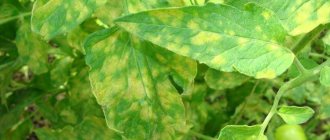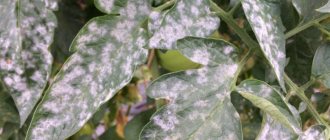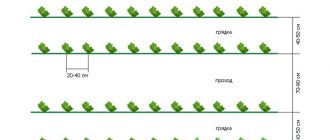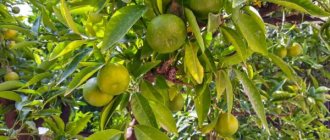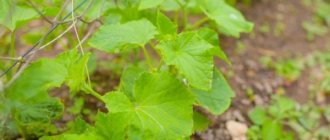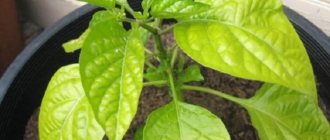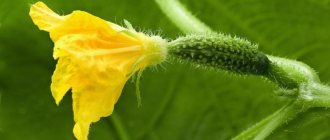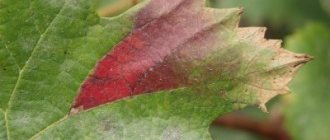Main reasons
There are plenty of reasons why vegetable leaves may turn yellow. Some of them are worth considering:
- Incorrectly set watering mode.
Watering too frequently or infrequently with insufficient amounts of liquid can cause dehydration in the plant. Too much watering contributes to the rotting of the crop.
- Lack of useful elements.
Cucumbers are vegetables that require regular nitrogen feeding. Often, a lack of nitrogen can cause yellowing of the foliage of a vegetable.
- The culture is frozen.
A sharp decrease in temperature leads to plant stress, resulting in yellow pigmentation on the leaves.
- Burn.
The scorching sun can burn the tops if there is moisture on them. Watering can only be done in the morning or evening, trying to prevent liquid from getting on the foliage.
- Diseases and fungi.
One of the common reasons why yellowing occurs is fusarium. This disease manifests itself in the form of wilting of the green part of the vegetable crop.
- Root damage.
The root system of cucumbers is very fragile, it is not difficult to damage it. This happens especially often during loosening and weeding of vegetables.
Important! To eliminate the possibility of improper watering of cucumbers, you should check how saturated the soil is with moisture. With proper watering, the soil should be moistened to a depth of 10 cm.
For what other reasons can leaves turn yellow and dry?
If, in addition to yellowness, the leaf becomes curled and begins to dry out, this may indicate the presence of serious problems.
- Lack of nutrients.
If the tops begin to lighten and the leaves curl downwards, the plant is most likely experiencing a nitrogen deficiency. To determine if this is actually the case, it is worth checking the leaves. If they stretch lengthwise and the leaf blade does not grow, then this is most likely the cause of yellow leaves. The problem can be solved by using complex fertilizers.
- Powdery mildew.
Midsummer is the period when the plant begins to suffer from this disease. For preventive purposes, it is worth spraying with a one percent Bordeaux solution from a spray bottle. If the crop grows in a greenhouse, then it must be ventilated regularly, especially after fertilizing.
- Insect pests.
If curling and blanching of the leaves appears, then it is worth inspecting them from the back side: perhaps they are being eaten by pests. Some of the common insects that prevent the plant from fully developing are aphids and spider mites. Only insecticidal and acaricidal fertilizer will kill these parasites.
- Viruses.
Cucumbers, like any vegetables, are susceptible to viral diseases. If a summer resident regularly waters and fertilizes, but the leaves still turn yellow, then most likely the vegetable has contracted a virus. Unfortunately, it is not easy to get rid of it.
In most cases, it is necessary to remove the affected plants from the garden bed before the disease spreads to the entire garden plot.
- Sudden change in temperature.
Frosts or scorching sun that burns the leaves negatively affect the development of cucumbers.
- Insufficient air humidity.
When there is a lack of moisture, the vegetable crop tends to hide its leaves to reduce evaporation. This phenomenon is not uncommon if the plant grows in greenhouse conditions. The problem can be eliminated by using the correct watering regime, ventilation and air humidification.
Methods for eliminating yellowed leaves
Each cause of yellowing has its own method of elimination:
If the lower leaves turn yellow from lack of light, then they simply need to be removed from the bush. They do not pose any particular danger to the plant.
Adjusting the plant irrigation regime is a way out of the cause of lack or excess of moisture. Water your cucumbers twice a week. To reduce moisture evaporation, mulch the soil under the bushes with straw or rotted sawdust. Water strictly under the bushes so that water does not get on the leaves. The soil must be saturated with liquid to a depth of at least 10-15 centimeters.
Folk, chemical and biological remedies will help get rid of fungal diseases:
- Garlic infusion will help cure plants at the first manifestations of the disease. Preparation: Chop 200 grams of peeled garlic cloves, add a liter of warm water, and leave to steep for a day. After that, strain the infusion through cheesecloth, dilute it in a bucket of water and add 30 grams of liquid laundry soap. Spray the plants with the resulting solution several times;
- “Fitosporin” is a biologically active drug that helps rid plants of fungal and bacterial diseases. To spray cucumbers, you need to dilute 10 grams of the powder substance in 5 liters of warm water. Treatment can be carried out every 10-14 days (if necessary);
- Bordeaux mixture will help cope with the most advanced forms of fungal and bacterial diseases. Preparation of the solution: add 100 grams of copper sulfate and 120 grams of slaked lime to ten liters of water, stir until the ingredients are completely dissolved. Apply the treatment no more than twice per season.
If pests appear on cucumbers, they must be exterminated immediately. A few parasites are not capable of causing death, but a dozen individuals are capable of destroying plants. An excellent chemical agent for killing parasites is the complex drug “Aktara”. To spray cucumbers you will need to dilute 4 grams in 10 liters of water.
To get rid of the deficiency of micro- and macroelements, use liquid fertilizers at the root. Any complex fertilizers that contain: magnesium, iron, copper, manganese, phosphorus, potassium are suitable.
Unfortunately, you cannot prevent sudden changes in weather conditions. High-quality care and timely feeding will smooth out the stress that leads to yellowing of the plant.
Damage to the root system can only be prevented. When weeding the beds, you do not need to insert the hoe blade deep, a maximum of a few centimeters to catch the root of the weed. Only pull up grass when the soil is moist. Firstly, it will break out better, and secondly, the soil will be destroyed less.
There is no way to prevent the natural death of leaves. If proper care is observed throughout the growing season, the plant will bear fruit until autumn.
Why do the lower leaves of cucumbers turn yellow?
Often this phenomenon occurs with the lower leaves. It happens due to the fact that in stressful situations, the vegetable crop devotes all its strength to the most unusual parts of the tops and its ovary, which contribute to the harvest. This is considered normal and is absolutely not a problem.
Besides this, there are plenty of reasons why this could happen:
- poor lighting (due to lack of light, the upper part of the plant remains green, and the lower part, which does not receive it, becomes yellow);
- non-compliance with watering rules (improper moistening of the vegetable contributes to wilting and the appearance of yellow spots on the foliage);
- lack of nutrients (if the lower leaves turn yellow, this indicates that the vegetable crop does not receive phosphorus, magnesium and potassium; to avoid this, only complex fertilizers should be used);
- fungus (the lower leaves are most susceptible to fungal diseases; to get rid of the scourge, you will have to tear off and burn the affected foliage - otherwise there is a high probability that the entire vegetable will become completely sick);
- aging of the crop (at the end of the growing season, the leaves of all plants turn yellow and curl).
It is worth paying attention: if warm weather suddenly changes to cold weather and rain, then the plant begins to be affected by a fungal disease.
It is necessary to timely fertilize with whey and garlic infusion. You need to take 1 liter of acidic composition and mix with 50 g of garlic infusion.
If the leaves of greenhouse cucumbers turn yellow
If you do not follow the rules of cultivation and care, the cucumber crop is often affected by many diseases that begin with yellowing of the leaf blade. In order not to encounter problems in growing, you must follow simple rules.
- Watering mode. During the flowering and fruiting period, plants are watered every 3 days with 5 liters of water per 1 square meter. meter. The need for watering is determined by the condition of the top layer of soil.
- Temperature conditions. Suitable temperature for growing cucumbers:
- before fruiting: daytime – 22–24 degrees, night – 16–18;
- during the formation of ovaries: daytime up to 26 degrees, night - not lower than 18 degrees.
To prevent the plant from starting to rot, it is necessary to ventilate the greenhouse or greenhouse in a timely manner. In hot summers this is most important, as it will reduce the risk of powdery mildew and other diseases.
- Landing rules. Yellowness on the foliage may appear due to dense planting. Closely planted plants prevent the penetration of sunlight and create favorable conditions for the emergence of various diseases.
Cause of yellowing of leaves and ovary
If the ovary turns yellow, this is a bad sign. There is a high probability that the plant’s yield will be zero. Therefore, at the first signs it is necessary to take immediate action.
Common causes of yellow leaves in open ground:
- lack of lighting (if the lower leaves do not receive sunlight, this is not dangerous, but when the top of the vegetable lacks it, this is very bad, this problem needs to be solved urgently);
- sudden frosts (the plant may freeze, resulting in a sign of yellowing of the leaves);
- lack of vitamins and minerals (cucumbers really need potassium and nitrogen, it is worth feeding with these fertilizers).
The leaves of cucumber seedlings have turned yellow
The reasons for yellowing of leaves in young plants grown on a windowsill are almost the same as in an adult plant. But there are several more reasons leading to this problem.
- Little space. If the seedlings grow in a pot that is too small, the foliage begins to turn yellow. The roots do not have enough space to develop, and as a result, the young plant is stunted in growth, and the leaf blade turns yellow. The problem can be solved - transplantation into a larger container.
- Lack of microelements. For good growth, young seedlings are fed with nitrogenous fertilizers at the stage of 2–3 true leaves.
Before planting in a permanent place, seedlings cannot be fed with organic matter.
In what cases can the edges of leaves turn yellow?
This symptom also has its reasons, it is worth considering some of them:
- powdery mildew suddenly attacked (this fungus affects the edges of the tops of the vegetable; special feeding should be done so as not to infect all cucumbers with the disease, usually Bordeaux mixture is used for this, but you should be very careful with it: improper use can harm the crop);
- lack of liquid (improper watering and dry air can give the effect of yellowing of the edges of the leaves);
- lack of potassium (the leaves of the cucumbers in the greenhouse have turned yellow; this often happens when the plant is not properly cared for).
In order to avoid this situation, you should use some recommendations:
- Carry out proper watering. When a cucumber actively blooms and bears fruit, it requires moisture once every 2-3 days.
- Maintain optimal temperature. In a greenhouse, it is very important to maintain air humidity levels and regularly ventilate.
- Feed with fertilizers. It is known that cucumbers need potassium and phosphorus. This feeding should be done regularly.
- Carry out prevention against harmful insects and fungal diseases.
- Do not plant the crop too thickly.
Why do cucumbers turn yellow in a greenhouse?
Why do cucumber leaves turn yellow in a greenhouse?
Very often, readers ask what to do if the leaves of cucumbers in a greenhouse turn yellow. First you need to find out why this happens, since the leaves of cucumbers in a greenhouse turn yellow for at least five reasons:
- violation of watering rules - lack or excess of moisture, watering plants with cold water, drops falling on the leaves when watering;
- insufficient lighting - as a rule, the lower leaves of plants turn yellow as a result, but there is no particular reason to worry about this natural phenomenon;
- lack of nutrients in the soil - nitrogen, magnesium, potassium, manganese, iron, copper or, conversely, oversaturation of the soil with fertilizers;
- damage to plants by diseases, such as powdery mildew, fusarium wilt, root rot or downy mildew;
- the presence of pests on cucumbers - melon aphids, whiteflies or spider mites.
Why do cucumbers dry in open ground and greenhouses?
Why do cucumber ovaries turn yellow in a greenhouse?
Why do cucumber embryos turn yellow? If you find that the cucumber ovaries have begun to turn yellow, check to see if one of these phenomena has occurred in the greenhouse:
- due to insufficient pollination, poor-quality ovaries were formed on cucumbers - this usually results from growing artificially pollinated varieties in the absence of pollinating insects;
- cucumbers are overloaded with too many embryos and cannot ensure their normal development - the formation of a large number of ovaries is an integral property of hybrid varieties that are intended for cultivation in a greenhouse;
- cucumbers are affected by pests or diseases - fusarium, downy mildew, rot, melon aphids or spider mites;
- plants were exposed to frost or there was a sharp temperature change - plants are not immune from this even in a greenhouse;
- the balance of nutrients in the soil is disturbed - there are not enough of them or, conversely, there are too many of them;
- the rules for watering cucumbers were violated.
Growing cucumbers in a greenhouse - planting and care
Why do cucumber fruits turn yellow in a greenhouse?
The fruits of cucumbers are for almost the same reasons as the leaves and ovaries, namely:
- Cucumbers: germination of seeds in 12 hours
- due to insufficient watering and violation of the temperature regime - cold water during irrigation, drafts or sudden cold snap;
- imbalance of nutrients in the soil;
- Cucumbers turn yellow even when fully ripe - this is a normal process. This cucumber cannot be eaten, but it can be left for seeds.
Prevention of yellow spots on cucumbers in open ground
To avoid this phenomenon, you should follow recommendations that will help keep your vegetable crop healthy:
- during sudden cold snaps, you need to cover the plant with film;
- follow watering rules;
- regularly fertilize with organic fertilizers;
- carry out prevention of fungal diseases and treatment against insect pests (inspect the plant under the leaves in order to detect damage in time);
- Watering should be done early in the morning or in the evening; this should absolutely not be done during the day, otherwise the plant may be burned by the sun’s rays.
The author of the video talks about some of the reasons for the yellowness of cucumber leaves around the edges and methods for preventing the disease.
How to water and feed cucumbers to prevent the leaves from turning yellow
It is best to feed cucumbers with complex fertilizers; you can buy them in garden stores or prepare them yourself.
Complex feeding is prepared from equal parts of potassium salt, superphosphate and ammonium nitrate.
One tablespoon of the prepared mixture is dissolved in ten liters of water, and the plants are watered with the prepared solution (1 liter for each bush).
You can make a green treat from grass and nettles.
Fill a large barrel 1/3 full with grass or nettles, add water, cover with plastic and leave for a week, remembering to stir every day. The prepared infusion (1:10) is poured over the cucumbers.
It is important to strictly follow the instructions on the packaging and fertilize after preliminary watering.
Treatment in the form of fertilizing
Experienced gardeners have long been using proven traditional methods for treating vegetable crops. To do this, use improvised means and simple products.
- Milk-soap fertilizer
To prepare this composition, you need to mix 10 liters of water, 1 liter of milk and laundry soap - 20-30 g, add 30 drops of iodine infusion. It is worth treating with the solution when the first pair of leaves appears on the crop. It is recommended to do this regularly - every 10 days.
- Feeding with bread with added iodine
To use this fertilizer, soak the bread (one loaf is enough) in 10 liters of water in advance overnight. In the morning, mash the bread gruel and add 1 bottle of iodine. Dilute the entire mixture in 10-12 liters of water and only then spray. The procedure should be repeated every 10-14 days.
- Onion infusion
Take a liter jar of onion peels and fill it with 12 liters of water. The mixture must be brought to a boil and left to brew for half a day. After this, dilute with water 1:4 and spray. The remaining composition should be poured under the root of the plant.
- Feeding with manganese crystals
When the first signs of yellowness begin to appear, the vegetable crop should be treated with a 1% solution of potassium permanganate.
How to deal with the problem?
If problems are detected with cucumbers, in order to get a good harvest, it is necessary to provide assistance to the plants as quickly as possible.
How to treat cucumbers if there is a lack of nutrition
To prevent the leaves from turning yellow and to improve the condition of the plants, you can use an infusion of mullein and ash. To prepare the fertilizer, it is recommended to pour 300 g of ash and 200 g of dry mullein into 10 liters of water, then leave for 24 hours. It is recommended to re-water the bushes after 7 days.
Treatment against diseases and pests
For fungal diseases, you can feed cucumbers with a 1% solution of Bordeaux mixture.
A solution of nitroammophoska quickly rids plants of aphids; for preparation, it is recommended to dissolve 2–3 ml in 10 liters of water.
See also: How to properly tie cucumbers in open ground
Using colloidal sulfur you can get rid of spider mites. The working solution is prepared in this way - 80 g of sulfur per 10 liters of water. It is recommended to treat bushes every 3–5 days.
To get rid of fungus and aphids, you can use a weak soap solution and wash the affected leaves. After this, the dark spots are sprinkled with ash, an alkaline environment is formed, unfavorable for fungi. It is recommended to carry out such treatment every 3–4 days until the pathological symptoms disappear.
In severe cases, you can use a soda solution, you need 1 tbsp. l. Dissolve the powder in 5 liters of water. Bushes are treated by spraying.
Note! When using soda, you must strictly follow the indicated dosage.
In other cases
To treat plants, reduce the risk of leaves turning yellow, and speed up their rehabilitation period, you can use the following recipes from folk sources:
- Milk-soap solution. To 8 liters of water add 500 ml of milk, 20 g of laundry soap, 20 drops of iodine, mix everything thoroughly. It is recommended to treat bushes every 10–12 days.
- Rye bread with iodine. A loaf of stale bread is soaked in 10 liters of water and ground until a homogeneous mixture is formed. The solution is filtered and 30–40 drops of iodine are added to it.
Preventative measures
What to do if cucumber leaves turn yellow? The easiest way is to prevent the problem than to take urgent measures to save the plantation in the future. Therefore, when cultivating a crop, it is important not only to follow the planting rules, but also to ensure proper care in the future:
- Careful preliminary (from autumn) preparation of the site for the beds (removal of plant debris, deep digging, application of organic mineral fertilizers).
- Maintaining crop rotation. The best precursors for the crop are peas, lettuce, early and cauliflower, as well as sederats.
- Place the lashes on trellises, so that they will have less contact with the ground, be evenly illuminated by the sun, and be well ventilated.
Related article:
Why do apple tree leaves curl: 5 reasons why this could happen
- Provide regular watering. If this is not possible (for example, the site is visited only on weekends), then after each application of water it is good to mulch the soil with sawdust or mowed grass.
- Apply complex fertilizers on time.
- Do not thicken the beds.
- Immediately respond to the appearance of pathological changes.
Could watering be the cause?
Also check out these articles
- How to make gardening work easier: drip irrigation and other life hacks
- Strawberry variety Gigantella
- What are the benefits of melon for women and men?
- Winter-hardy varieties of peaches
Very often, the cause of yellowing of cucumbers is an abundance of moisture. If there is not enough of it, the plant simply dries out, but when there is too much, the leaves turn yellow. That is why it is not recommended to fill the plant with water for future use if it is very hot outside or you are too lazy to do it every day.
Very often, the cause of yellowing of cucumbers is an abundance of moisture.
The amount of water for cucumbers depends on many factors: lighting, soil type, time of year, period of crop development, planting location, groundwater level, as well as variety, and so on. That is why it is difficult to name the exact displacement for each sprout. In order for the plant to always have enough water, you need to use a primitive method - stick your finger into the ground and if it is cool and humid there, watering is not required, if it is dry and hot, then it is necessary.
And one more important point - water that has been heated in the sun, settled, is always used for irrigation. The procedure itself is carried out at the root!
